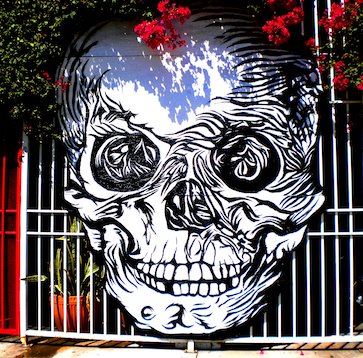 Facebook
Facebook
 X
X
 Instagram
Instagram
 TikTok
TikTok
 Youtube
Youtube

Los Angeles is a city of divides: poverty and decadence, history and trend, life and death. And the city of angels has its share of death, as evident by two Hollywood attractions, the Museum of Death and Psychiatry: An Industry of Death. A fabulous day out for horror-hounds.
The Museum of Death on Hollywood Blvd (whose $15 fee includes parking – in Hollywood!) is a fun and fascinating way to spend a few hours, as long as you don’t take it too seriously. The couple who run the museum could not be sweeter, but don’t be fooled, it’s definitely not for the fainthearted: explicit footage of autopsies and executions, gory photographs of car accidents and dismemberment, a whole room dedicated to serial killer art and memorabilia.
I was particularly interested to see the bunk beds from the Heaven’s Gate suicide cult, complete with applesauce pots and black-and-white Nikes. The tour concludes with a mock-up (or is it?) electric chair for the obligatory bad taste photo-op.
On our way out we asked one of the owners, James, how he compiled his rare and repulsive collection. He explained the painstaking process of corresponding with incarcerated killers to persuade them to donate poetry, paintings or doodles. Rather than emulating these individuals, he assured us that all serial killers are “complete jerks.” What a guy!
Just blocks away on Sunset is Psychiatry: An Industry of Death. This museum is funded by the Church of Scientology, so expect a religious slant; there’s no entry fee, but you will be subjected to an intense introduction on the way in and a half-assed conversion on the way out. As a psychotherapist, I tried to go in with an open mind and bit my tongue.
Unlike the Museum of Death, the presentation in Psychiatry is impressively overdone. Some of the exhibits are upsetting – the Nazi death camp complete with overhead gas-showers, especially. In brief, the museum asserts that psychiatry is solely responsible for human evils such as the Holocaust, 9/11, racism, celebrity death...and all crime ever. High-quality films on widescreen TVs accompany each provocative point.
It was an emotional journey. The constant insinuation that mental health professionals thrive on the sadistic torture of the vulnerable does wear thin, and some exhibits were too distressing for more than a passing glance.
There is no denying that psychiatry has a dubious past, but no matter how well-meaning (and well-funded) the “message,” the museum’s claims are absurd, incorrect and downright paranoid. But that’s what makes it an experience. If you can swallow your indignation and appreciate the museum for what it really shows (the power of fear, indoctrination and lucrative religious cults), it’s worth a visit for the spectacle alone.
Finish the day with a stroll around the serene Hollywood Forever Cemetery on Santa Monica. A sweet reminder that busboy or starlet, A-list or Z-list, we all end up in the same place.
Los Angeles. What a crazy city. Don’t ever die.


Los Angeles is a city of divides: poverty and decadence, history and trend, life and death. And the city of angels has its share of death, as evident by two Hollywood attractions, the Museum of Death and Psychiatry: An Industry of Death. A fabulous day out for horror-hounds.
The Museum of Death on Hollywood Blvd (whose $15 fee includes parking – in Hollywood!) is a fun and fascinating way to spend a few hours, as long as you don’t take it too seriously. The couple who run the museum could not be sweeter, but don’t be fooled, it’s definitely not for the fainthearted: explicit footage of autopsies and executions, gory photographs of car accidents and dismemberment, a whole room dedicated to serial killer art and memorabilia.
I was particularly interested to see the bunk beds from the Heaven’s Gate suicide cult, complete with applesauce pots and black-and-white Nikes. The tour concludes with a mock-up (or is it?) electric chair for the obligatory bad taste photo-op.
On our way out we asked one of the owners, James, how he compiled his rare and repulsive collection. He explained the painstaking process of corresponding with incarcerated killers to persuade them to donate poetry, paintings or doodles. Rather than emulating these individuals, he assured us that all serial killers are “complete jerks.” What a guy!
Just blocks away on Sunset is Psychiatry: An Industry of Death. This museum is funded by the Church of Scientology, so expect a religious slant; there’s no entry fee, but you will be subjected to an intense introduction on the way in and a half-assed conversion on the way out. As a psychotherapist, I tried to go in with an open mind and bit my tongue.
Unlike the Museum of Death, the presentation in Psychiatry is impressively overdone. Some of the exhibits are upsetting – the Nazi death camp complete with overhead gas-showers, especially. In brief, the museum asserts that psychiatry is solely responsible for human evils such as the Holocaust, 9/11, racism, celebrity death...and all crime ever. High-quality films on widescreen TVs accompany each provocative point.
It was an emotional journey. The constant insinuation that mental health professionals thrive on the sadistic torture of the vulnerable does wear thin, and some exhibits were too distressing for more than a passing glance.
There is no denying that psychiatry has a dubious past, but no matter how well-meaning (and well-funded) the “message,” the museum’s claims are absurd, incorrect and downright paranoid. But that’s what makes it an experience. If you can swallow your indignation and appreciate the museum for what it really shows (the power of fear, indoctrination and lucrative religious cults), it’s worth a visit for the spectacle alone.
Finish the day with a stroll around the serene Hollywood Forever Cemetery on Santa Monica. A sweet reminder that busboy or starlet, A-list or Z-list, we all end up in the same place.
Los Angeles. What a crazy city. Don’t ever die.
Comments